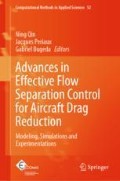Abstract
A set of active flow control methods on controlling flow separation and drag reduction over a NACA0015 airfoil were numerically studied by solving three-dimensional incompressible unsteady Reynolds-averaged Navier-Stokes equations. Four achievements have been made: (1) Through the comparison of several turbulence models, DES k-epsilon model was adopted since it can well capture the unsteady separation around the airfoil. (2) The numerical results of a NACA0015 airfoil without/with the blowing/suction and pulsed jets as flow control devices have been proved to be very consistent with the experimental results. (3) The trends of Reynolds stresses were analyzed to reveal the flow-control mechanism over airfoil under various active flow control devices. (4) A fluidic mechanism for pulsed jets and blowing/suction devices can significantly improve the control performance, and optimization could be conducted to obtain better results in the future.
Access this chapter
Tax calculation will be finalised at checkout
Purchases are for personal use only
References
Siauw W, Bonnet JP, Tensi J et al (2009) Physics of separated flow over a NACA 0015 airfoil and detection of flow separation. In: 47th AIAA aerospace sciences meeting, AIAA paper 2009-144
Siauw WL, Bonnet JP, Tensi J et al (2010) Transient dynamics of the flow around a NACA 0015 airfoil using fluidic vortex generators. Int J Heat Fluid Flow 31(3):450–459
Geissler W (2010) A family of CFD boundary conditions to simulate separation control. Aerosp Sci Technol 14(7):494–504
Hwang D (2004) Review of research into the concept of the microblowing technique for turbulent skin friction reduction. Prog Aerosp Sci 40(8):559–575
Hwang DP (2002) Experimental study of characteristics of micro-hole porous skins for turbulent skin friction reduction. In: Proceedings of the 23rd congress of international council of the aeronautical sciences, Toronto, Canada, 2002. Optimage Ltd, pp 2101.1–2101.7
Li J, Lee CH, Jia L et al (2009) Numerical study on flow control by micro-blowing. In: Proceedings of 47th AIAA aerospace sciences meeting and the new horizons forum and aerospace exposition, Orlando, Florida, USA, 2009, pp 8928–8946
Li X, Ren Y (2004) Detached-eddy simulation k-ε turbulence model and its application in fire simulations (in Chinese). J Tsinghua Univ (Sci Technol) 44(8):1126–1129
Spalart PR, Jou WH, Strelets M et al (1997) Comments on the feasibility of LES for wings and on a hybrid RANS/LES approach. In: Liu C, Liu Z (eds) Proceedings of 1st AFOSR international conference on DNS/LES, Louisiana, USA, Aug 1997. Advances in DNS/LES. Greyden Press, Columbus, USA, pp 137–147
Menter FR (1994) Two-equation eddy-viscosity turbulence models for engineering applications. AIAA J 32(8):1598–1605
Travin A, Shur M, Strelets M et al (2000) Detached-eddy simulations past a circular cylinder. Flow Turbul Combust 63(1):293–313
Gilarranz JL, Traub LW, Rediniotis OK (2005) A new class of synthetic jet actuators: part II: application to flow separation control. J Fluids Eng 127(2):377–387
Liu F, Zou J, Zheng Y (2013) Effect of synthetic jets physical parameters on flow separation control over airfoil (in Chinese). J Zhejiang Univ (Eng Sci) 47(1):146–153
Acknowledgements
Research reported in this paper has been investigated in the MARS project entitled “Manipulation of Reynolds Stress for Separation Control and Drag Reduction”, and supported by PRC-MIIT and EC-DG RTD Chinese and European governmental institutions.
Author information
Authors and Affiliations
Corresponding author
Editor information
Editors and Affiliations
Rights and permissions
Copyright information
© 2020 Springer Nature Switzerland AG
About this chapter
Cite this chapter
Xie, L., Zheng, Y., Zou, J., Ji, T., Shi, X., Xie, F. (2020). Effects of Flow Control Devices on an Airfoil. In: Qin, N., Periaux, J., Bugeda, G. (eds) Advances in Effective Flow Separation Control for Aircraft Drag Reduction. Computational Methods in Applied Sciences, vol 52. Springer, Cham. https://doi.org/10.1007/978-3-030-29688-9_17
Download citation
DOI: https://doi.org/10.1007/978-3-030-29688-9_17
Published:
Publisher Name: Springer, Cham
Print ISBN: 978-3-030-29687-2
Online ISBN: 978-3-030-29688-9
eBook Packages: EngineeringEngineering (R0)

